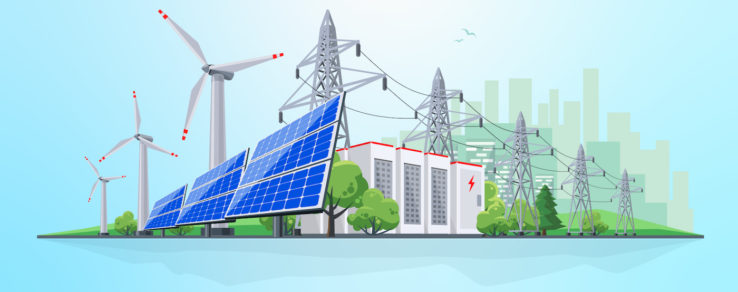Questline Digital energy expert Mike Carter shares his analysis of energy storage technology and the outlook for utilities.
Electrical energy is transitory in nature. It is generally consumed as soon as it is produced. This requires closely matching power generation with consumption, which is complex and costly. Energy storage systems (ESS) are a great enabler that can temper this requirement. In fact, energy storage can provide over a dozen general electricity services to the electric grid. Deployments of energy storage capacity almost doubled from 2018 to 2019 and were poised for explosive future growth prior to the COVID-19 pandemic, primarily from the residential market.
Policies like utility integrated resource plans (IRP) and favorable distributed generation interconnection rules have driven the front-of-the-meter (FTM) market. Federal Energy Regulatory Commission (FERC) Order 841, approved in February 2017, leveled the wholesale energy and capacity FTM markets by treating storage as a generation resource. Monetary incentives from states and utilities, plus improved resiliency have driven the behind-the-meter (BTM) market.
The Rocky Mountain Institute (RMI) has identified 13 services that energy storage can provide to three stakeholder groups from delivery of each service. The stakeholder groups and benefits are:
- Independent system operators (ISOs) and regional transmission organizations (RTOs)
- Energy arbitrage
- Spin/non-spin reserve
- Frequency regulation
- Voltage support
- Black start
- Utilities
- Resource adequacy
- Transmission congestion relief
- Transmission and distribution construction deferral
- Customers (BTM only)
- Time-of-use bill management
- Demand charge reduction
- Increased PV solar self-consumption
- Backup power
For customers, energy storage can meet on-peak demand with excess energy produced by baseload generation and renewables during off-peak hours. This reduces or eliminates peak customer demand charges. ESS also makes it much easier and cost-effective to add wind and solar energy to the grid.
There are generally seven categories of energy storage technologies:
- Electrochemical batteries — mainly capacitors
- Kinetic flywheels — mechanical devices that harness rotational energy to deliver instantaneous electricity
- Static chemical batteries — a range of electrochemical storage solutions, including advanced chemistry batteries
- Thermal storage — capturing heat and cold to create energy on demand, including ice storage
- Chemical flow batteries — batteries where the energy is stored directly in a circulating electrolyte solution for longer cycle life and quick response times
- Compressed air energy storage — utilizing compressed air to create a potent energy reserve
- Potential energy — pumped hydro-power creating large-scale reservoirs of energy with water or a tower out of stacked bricks (such as Energy Vault)
Lithium-ion chemistry dominates the static chemical battery market, accounting for 98% of power capacity in new deployments. It offers a much higher power density (smaller footprint), more cycle rates, greater depth of discharge and longer life than lead acid batteries. Li-ion batteries are almost exclusively used in electric vehicles and are making inroads into uninterruptible power supplies (UPS) for data centers.
- Tesla commercial Powerpacks and residential Tesla Powerwalls have been available for some time.
- Green Charge, AES Distributed Energy and LG Chem are other major Li-ion battery storage suppliers.
- Solar plus battery storage (solar+) is also a growing market sector.
- Yotta SolarLEAF photovoltaic panels each come with 1 kWh of integrated Li-ion energy storage per panel for BTM applications.
Because there is inherent hazard from the malfunction of any kind of battery, NFPA 855 Standard for Installation of Stationary Storage Systems requires fire-rated separation of the ESS from other indoor occupancies in non-dedicated (unpopulated) use buildings. Every 50 kWh grouping of ESS is to be separated by three feet from each other and from the walls of the room. A maximum 600 kWh of batteries can be installed in one room. Fire detection plus suppression and control is required. Almost every type of battery must have built-in thermal runaway protection. UL9540 Standard for Energy Storage Systems and Equipment defines a test method to evaluate the fire characteristics of a battery energy storage system and can provide exceptions to NFPA 855 requirements.
Deploying solar+ energy storage has some major challenges. A recent report by the American Council for an Energy-Efficient Economy states, “Regulators often require utilities to offer energy efficiency and solar in separate siloed programs with different funding sources, cost-effectiveness tests, and reporting requirements.”
Also, it is not yet clear whether FERC Order 841 supports value-stacking of different energy storage services like backup power and peak demand reduction together. Thus far, only one service has been allowed per application. In addition, energy storage is a capital-intensive technology that does not fit well into a marginal cost-centric electricity market.
Energy storage can solve many problems along the energy supply chain. Utilities can advance the energy storage market by ownership of customer-sited storage, use of tariffs to encourage energy-storage deployment and grid integration of utility-scale energy storage. There are also several useful energy storage resources:
- The U.S. Energy Storage Association (ESA) advocates and advances the energy storage industry.
- ES-Select created by DNV GL in collaboration with Sandia National Labs allows users to screen energy storage technologies by calculating financial outputs.
- DNV GL’s annual Battery Performance Scorecard provides independent ranking and evaluation of battery vendors based on testing performed in DNV GL’s laboratories.
Energy storage, by corralling the transitory nature of electrical energy, is presenting exciting opportunities not previously available.
Mike Carter is a Senior Engineer at Questline Digital. He has a BS in Engineering and an MBA degree from Ohio State University and is a Certified Energy Manager.

